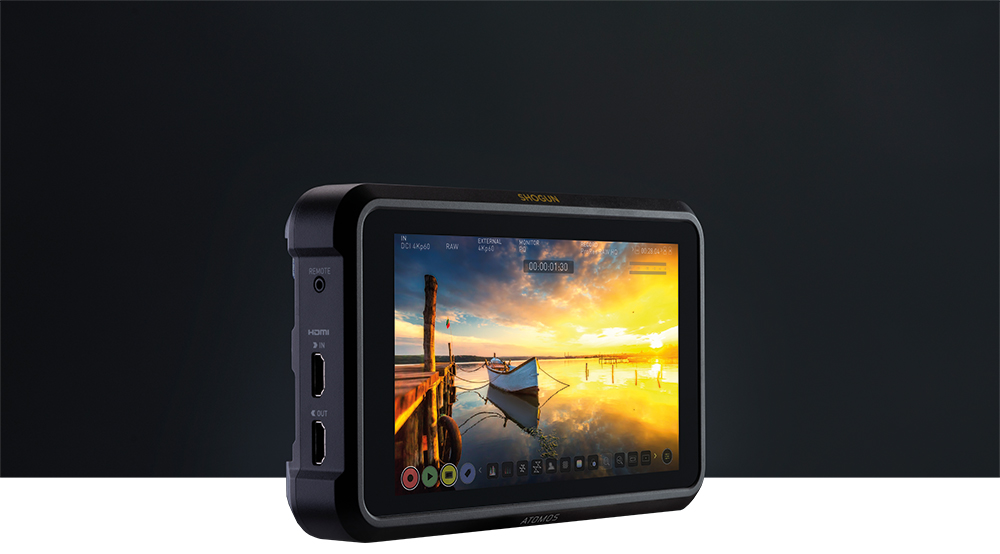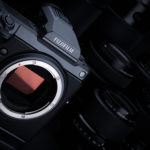
Atomos Shogun 7
Posted on Oct 17, 2019
Just when you thought field monitors couldn’t get any more advanced, Australian firm Atomos continues to push the envelope with its Shogun 7 precision HDR monitor recorder
Words Adam Duckworth / Pictures Adam Duckworth / ATOMOS
Long gone are the days when external monitors were just that – to help monitor what the camera is capturing. First came recording, thanks to large-capacity, fast SSD drives unlocking higher bit rates and colour depth from the majority of cameras, and Raw recording from others. All converted to edit-ready ProRes in a variety of formats.
Add in efficient monitor tools like waveforms and vectorscopes then, of course, make the screens very bright for outdoor use. Next came HDR for the next-generation TV screens. Then, in high-end Atomos units, the ground-breaking Apple ProRes Raw offers the benefits of Raw without the huge file sizes.
IT CAN BE USED AS A FLEXIBLE MASTER RECORDER FOR LIVE STREAMING
New features
Now the Atomos Shogun 7 adds in live switching, making it ideal for event coverage, especially with the boom in live streaming platforms. Of course, for £1558/$1499, it’s not going to replace a dedicated switcher for outside broadcast TV as it’s limited to four inputs but, for the majority of small crews, can be used as a flexible master recording and production station for livestreaming.
The Shogun 7 can monitor, record and switch between four live HD SDI video streams with genlock in and out. After the streams are recorded, you can then import the Atomos XML file into your editing software and your timeline populates with all your edits in place. The mixed analogue stereo audio is also imported, as well as two channels of digital audio embedded in each stream.
With HDMI 2.0v, you can capture up to 4K60p or via Quad Link, Dual Link or Single Link. It also allows slow-motion capture in 2K at up to 240p.
You can also check how your content will look on high-resolution TV sets in real time with the Dolby Vision output.
 The I/Os for the Shogun7
The I/Os for the Shogun7
Interface
We’d love to report how good the unit is as doing all this, but unfortunately the switching, 240fps slow motion and Dolby Vision support is not available at launch. It will come via a free firmware upgrade very soon, promises Atomos.
Until then, the unit performs very much like Atomos’ Shogun Inferno monitor recorder, although it does have a different body and new user interface that makes it a step above the well-known Inferno unit. And new screen technology makes the screen appear more consistent, right to the edges.
The HDR screen uses what Atomos call Dynamic AtomHDR backlit technology, with 360 zones that give a 1,000,000:1 contrast ratio, with ultra-wide colour for very deep blacks with lots of detail and – thanks to the 1500 nit LCD – vivid, bright performance. We couldn’t measure the claims, but the unit does look brighter and more consistent across the screen, even when compared to the Shogun Inferno, which itself is one of the best screens on the market.

Suited for cinema
As a seven-inch unit, the Shogun 7 is best suited for cinema cameras, although it can work well on small mirrorless cameras which, thanks to their large sensors, need critical focusing. The Shogun 7 helps in this regard thanks to proper monitoring tools like focus peaking, on which you can set not only the colour, but also the on-screen effect. For mirrorless cameras, an external monitor recorder makes sense, as recording to SSD cards means there is no time limit and, in most cases, higher quality footage is recorded.
The majority of these small cameras record 4:2:0 in 8-bit internally, but via HDMI can output 4:2:2 in 8 or 10-bit. That gives a lot more colour information and is a huge benefit if you are shooting Log footage. This is all via HDMI, but the Shogun 7 also has SDI inputs for use on cinema cameras such as the Sony FS series, Panasonic EVA1 and Canon EOS C series, where Raw recording for the ultimate quality is one of the biggest benefits.
These are recorded to standard SSD cards, which fit inside Atomos caddies that slide into the back of the unit. Next to this are two battery slots for NP-F style cells. Using two large batteries does make the unit a bit top-heavy, so we powered it from the camera battery, which has a D-Tap outlet, using the correct Atomos cable to link to the screen. The screen can also be powered via mains for on-set use if there is a mains supply.
The Atomos 7 has the latest AtomOS operating system, which is quick and easy to navigate, with menus that are straightforward and obvious. The screen itself is very responsive to the touch.
To monitor the signal there are waveforms, false colour, vectorscope, focus peaking, instant zoom and Atomos’ own HDR feature, as well as viewing LUTs.
 The Shogun 7 has a 1500 nit LCD screen with the Atomos Dynamic AtomHDR backlit technology
The Shogun 7 has a 1500 nit LCD screen with the Atomos Dynamic AtomHDR backlit technology
Construction
The Atomos 7 feels like a solid unit and has lots of connection options, such as the SDI connectors, audio input, a 3.5mm headphone jack, remote jack and full-size HDMI input and output sockets, so you can link it up to another monitor.
The top and bottom of the unit has standard 3/8-inch accessory mounts, and we used a SmallRig mini monitor connector with no problems once it was tightened enough.
For audio, there is a mini XLR input that is missing on Atomos’ smaller units like the five-inch Ninja V. So you can use 48V stereo mics via the balanced XLR breakout cable. If you select mic or line input levels, you can record up to 12 channels of digital audio from HDMI or SDI.
For not a lot more money than the Atomos Shogun Inferno, the Shogun 7 is a step ahead in terms of its screen and user interface, so is ideal for cameramen who want a better view, directors or focus pullers. And when the firmware upgrade brings live switching as well as 240fps in 2K and Dolby Vision monitoring, then it will truly be in a class of its own that many will find hard to resist.








